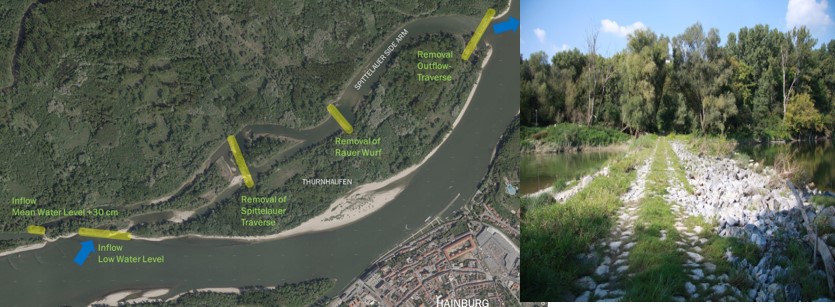Spittelauer Arm


NBS info
| Country | Austria |
| River, water body | Danube |
| Stage | ME |
| Size | Big |
| Geotype | International |
| Innovative Solutions | No |
 |
 |
 |
Project summary
“Spittelauer Arm” renaturalisation action has been planned, extends from Petronell to Hainburg, and it has already been part of several renaturation actions. Overall, the restoration goals were aligned towards the ambition of reestablishing the hydrological connection of this river stream with its floodplain and the Danube River. The “Spittelauer Arm”’s basic restoration principle is based on working with the existing stream flow and removing the traverse elements to enhance the floodplain connection. In the course of this, an overall understanding of the ecological elements and river ecosystems’ landscape helped to define smart restoration strategies, such as the use of dismantled stones, which were reused from other projects’ construction actions in the area.
Best practices and references
As a practical reference to nurture the implementation of these kinds of actions, a "guidance document for river engineering management on the Danube east of Vienna" was drafted (“Flussbauliches Managementleitbild für die Donau östlich von Wien”). In it, the objectives as well as the management principles and working methods required to achieve the objectives were agreed between business representatives and environmental organisations. The document is considered a strategic guideline for the further course of action in the catalogue of measures. The document is only available for download in German language.
Environmental, socio-cultural, economic impacts
Many positive impacts can be considered from the implementation of this project, such as biodiversity enhancement as well as socio-cultural and economic benefits to the residents. For instance, this especially applies to the area of ‘Thurnhaufen’, which is localised in the opposite front of the city of Hainburg, and turned into an alluvial forest that serves as a retreat for visitors and residents. Overall, the LIFE project enhanced many opportunities to the communities for interacting with the natural environment and helped to maintain, restore, and increase the ecological value of along the tributaries, turning them into lifelines of the floodplain forests. Riparian forests deliver multiple benefits that can be monetised. In total, the Dynamic LIFE Lines project ecologically upgrades over 1500 hectares of riparian forests.
Replication and scalability
The replicability of this kind of restoration action is key in effective watershed restoration and the LIFE project allowed various small interventions along the Upper and Middle Danube region to help in improving the ecological state of this floodplain. A historical track on environmental assessment and monitoring of the watershed helps evaluate the benefits from the implementation of the restoration practices, to demonstrate the importance of replication and scalability for the achievement of our environmental goals. This project has been preceded by several other restoration measures in the area, such as the side-arm reconnection in Haslau Regelsbrunn, finished as early as 1998. The evaluation of the results from the implementation of the previous experiences shows us that the methods applied can be easily replicated and upscaled
Participation process
All measures for the Danube east of Vienna are accompanied and supported by a stakeholder forum. Thereby, affected and interested parties have the possibility to be actively involved in the realisation of the measures and contribute to the way of implementation and evaluation within the given legal framework. Key element of the model is an advisory board, consisting of members of organisations and advocacy groups having a professional relation to the national park area.
Lessons learnt
As a main lesson, the LIFE project demonstrates that there are two essential elements for the achievement of the projects’ goals, increasing biodiversity and hydrological dynamics and the regeneration of riparian buffers to transform the tributaries of the Danube into real lifelines. This translates into an important message given the importance of preserving last Europe-wide riparian forests on the Austrian Danube and showed that restoration of lifelines will significantly contribute to this aim.
